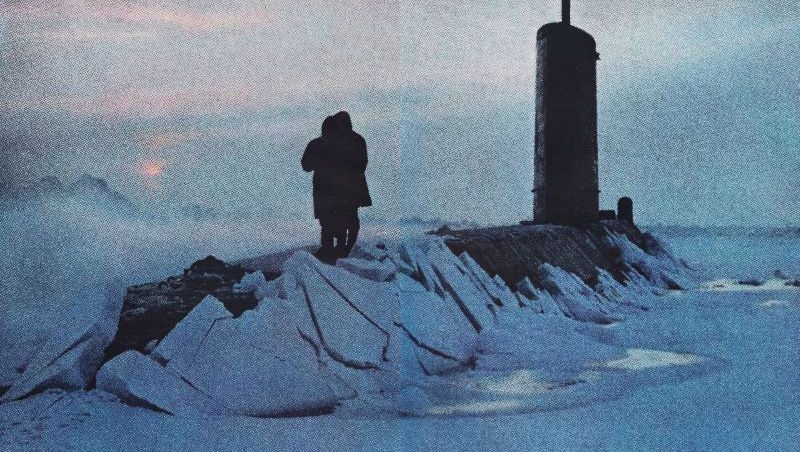In the early 1950s, top secret efforts led to the first submarine trips to the North Pole by USS Nautilus and USS Skate in 1957 – dramatic successes that rivaled the Soviet Union's Sputnik that year – and shifted the balance of strategic power.
-
Spring 2018
Volume63Issue1
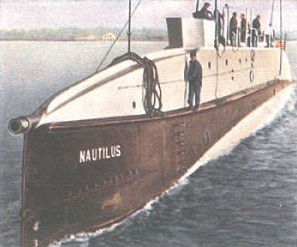
“If World War III should come, its strategic center will be the North Pole,” declared Gen. Hap Arnold, commander of the U.S. Army Air Forces during the Second World War. But in the Navy few officers paid much attention to his warning. As the two superpowers squared off against each other in the 1950s in Korea, Berlin, and other trouble spots, the vast expanse of the Arctic Ocean remained relatively quiet. Air Force planes patrolled the frozen northern frontier from such distant bases such as Thule in Greenland and a few remote radar stations stood guard to detect incoming Soviet bombers. But the Navy largely ignored the vast expanse of ice.
That changed dramatically in 1957. The world was shocked on August 3 when news broke that an American submarine had secretly reached the North Pole underwater. Coming only a few months after the Soviet's stunning success with Sputnik, the feat greatly buoyed the public's spirit. “Few maritime exploits in history have so startled the world as the silent, secret transpolar voyage of the U.S. Navy’s nuclear submarine Nautilus," wrote Paul O'Neil in LIFE Magazine at the time, "and none since the age of Columbus and Vasco de Gama has opened, in one bold stroke, so vast and forbidding an area of the seas."
The following year, the USS Skate would actually break through the ice and surface at the Pole. But these great successes only came after a decade of hard work, and extraordinary technological innovations.
For centuries, explorers had discovered mostly tragedy in the Arctic. Henry Hudson died in the frozen sea that was later named for him, and the Franklin, Jeannette, and Greely expeditions all ended in misery and death.
Submarines at the time could go only a little further north than surface ships. In 1930, the Navy sold a World War I-era submarine to a private Arctic expedition led by explorer Sir Hubert Wilkins, who renamed the sub Nautilus, after the vessel in Jules Verne's 20,000 Leagues Under the Sea. But the old boat lacked insulation and heaters, and was ill-equipped to deal with Arctic challenges. Fresh water pipes froze and the hull leaked.
Wilkins and Nautilus reached 82° N, the farthest north any ship had gone under its own power. The expedition’s chief scientist Harold Sverdrup took core samples of the sea bottom, and recorded bathymetric and gravitational data. But when the sub reached the actual ice pack, the crew didn’t want to risk going further. Nevertheless, Wilkins ordered the submarine onward under the ice. However, its dive planes malfunctioned (perhaps sabotaged by the crew) and its ability to submerge was impeded.
At the time Wilkins and his crew knew so little about the underside of the Arctic ice that they thought they could "sled" along the bottom of the ice pack in a 175-foot-long submarine skidding along like an upside-down dog sled. “The noise of the ice scraping along the top of the vessel was terrifying,” the explorer wrote later. “It sounded as though the whole superstructure was being demolished.”
World War II-era submarines were not much better at traveling under the ice. They were slow under water, traveling less than 10 mph, and needed to return to the surface after a few hours to take in air for the crew and diesel engines, and run their diesel engines to recharge the batteries that powered them under water. Crucially, they lacked the technology to see the ice pack above and the dangers of icebergs ahead. The German U-262 transited 12 hours under the ice during the World War II and in 1947 the USS Boarfish was able to proceed six miles under the ice before having to turn back. But reaching the North Pole 1,200 miles away remained a distant impossibility.
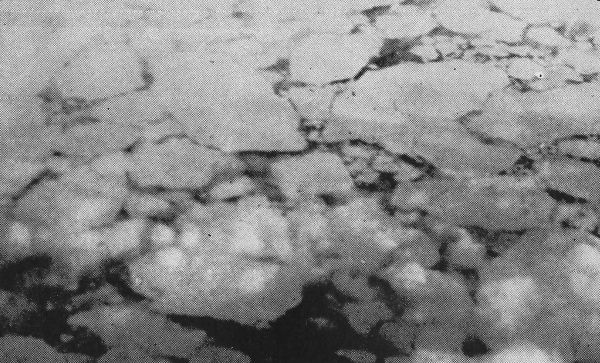
In 1948, former wartime sub commander Robert McWethy was an instructor at the Navy school in Monterey when he was asked to teach Arctic navigation — a particularly difficult subject since even the modern gyrocompasses didn’t work well in the far North and the frequent fog and stormy weather made celestial navigation difficult. In order to learn about new navigation techniques being tested by the Air Force, McWethy hitched a ride on a B-29 conducting weather reconnaissance over the North Pole.
As the bomber droned its way across the Arctic expanse, McWethy stared out the window at long sheets of ice pack broken by ice hills and disturbance where large flows had collided. He was surprised to see open water in some places as large cracks and even small lakes opened up where the ice had shifted. From the air, the open water appeared a striking black against the nearly endless white of the ice pack. Perhaps, McWethy thought, a submarine could navigate the Arctic if it could surface at those openings for air.
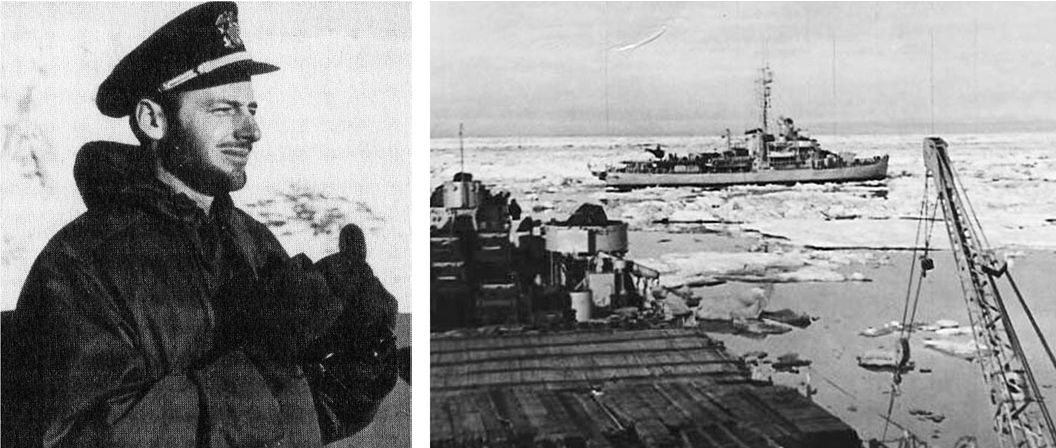
McWethy wanted to experience the Arctic firsthand. “I discovered the Navy had two icebreakers,” he recalled recently. “So I requested assignment to one of them.” The reply was, “Don’t be ridiculous.” Navy higher-ups saw no reason to put an experienced submarine officer on such a duty. But McWethy was persistent, and eventually won a spot as executive officer of the Pacific Fleet’s one icebreaker, USS Burton Island. Duties on the ship included scientific research, military exercises, and helicopter reconnaissance of ice flows.
On board Burton Island, McWethy became good friends with Waldo Lyon, founder and chief scientist of the Navy’s Arctic Submarine Laboratory. Waldo was developing a revolutionary new depth meter for submarines that would point upwards toward the ice pack, instead of down to the sea bottom, in order to measure the distance to the ice and its thickness.
“The idea of submarines operating beneath the ice soon became an obsession for McWethy,” recalled William Anderson, who was later captain of the nuclear submarine USS Nautilus. “Russia was the new threat. The Arctic region was in Russia’s backyard. What better platform from which to stealthily operate and keep an eye on them than a submersible ship?" But little was known about the depth of the water in the Arctic. In the two years McWethy served on Burton Island, the icebreaker took soundings for 1,000 miles along the coast of Alaska. The Bering Straits were so shallow that during the last ice age they had actually been dry land forming a 600-mile wide bridge between Asia and North America. But further north, there was deep water closer to the Pole.
At the Naval War College in 1951, McWethy wrote an essay on the possibilities of submarines under the ice. "I sent it down to Washington," he recalled recently, "but it got a cool reception." Frustrated, McWethy removed the classified information in the article and sent it to Naval Proceedings for publication in September, 1952. That year, the Navy did send the USS Redfish under the ice to test Waldo's new upward-looking fathometer, and the diesel sub was able to penetrate more than twenty miles under the ice pack. But the Navy's top brass still ignored the Arctic's possibilities.
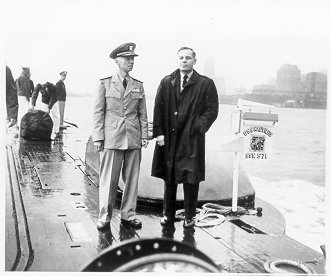
What would make Lyon and McWethy's vision possible was the extraordinary work done by Capt. (later Admiral) Hyman Rickover and his engineers in developing nuclear reactors small enough to fit on a Navy ship and power its engines. "It is difficult in this day and age to imagine how wacky that idea seemed to most people, both inside and outside the navy," Capt. Anderson of Nautilus later recalled.
After WWII Rickover was sent to the Oak Ridge Laboratory to look into developing nuclear propulsion. But his ideas were so controversial that he was recalled from Oak Ridge and assigned "advisory duties" back in Washington. His office was an abandoned ladies room in the Navy Building. But Rickover was not one to let insults stand in his way. Rickover later circumvented the normal chain of command and went directly to the Chief of Naval Operations. Luckily, the CNO in the late 1940s was Adm. Chester Nimitz, an expert on submarines who approved Rickover's far-fetched proposal to build nuclear propulsion systems from ships.
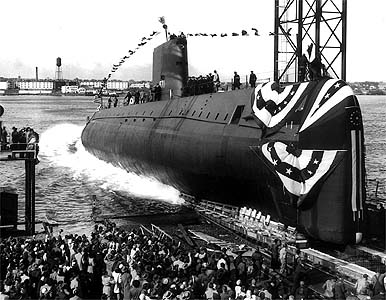
The top secret Naval Reactors Branch headed by Rickover took up the challenge of building a nuclear reactor that needed to be a maximum of 28 feet wide. It developed systems to transfer heat from the intensely radioactive, closed-water circuit that ran through the reactor and then drive a steam-turbine system that provided electricity to run the motors. Nuclear-powered engines did not need to surface for oxygen, and with CO2 scrubbers to clean the air submarines could remain underwater for long periods of time. As a happy by-product, the system could also provide distilled water for drinking and other uses by the crew.
On the morning of January 17, 1955, Nautilus' first Commanding Officer, Commander Eugene P. Wilkinson, ordered all lines cast off and signaled the historic message, "Underway On Nuclear Power."
"Few events in history have had as much impact as the launch of this remarkable vessel," her second commander, Capt. Anderson later wrote. "That sounds like an overstatement, but that one submarine literally changed everything about naval and nuclear warfare, about how nations defend themselves, about exploration of the earth's oceans."
Nautilus was so quiet that it was difficult to detect her with existing sonar. She was so fast and maneuverable, and able to dive so quickly and stay submerged, that she made existing anti-submarine warfare tactics obsolete. In fleet exercises, she chalked up a record numbers of “kills.”
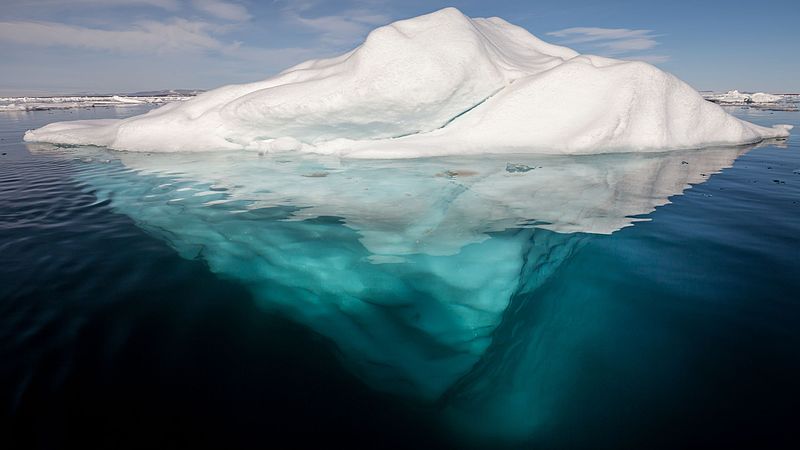
But her success also meant that Nautilus was extraordinarily valuable to the U.S. Navy. Its top admirals were reluctant to send the precious nuclear submarine on a risky exploration of the Arctic, where uncharted waters could hide dangerous seamounts. Nor had anyone really surveyed much of the underside of the ice pack. It was also known that 90% of an iceberg floats below the water surface. For a submarine even to bump against the edge of an iceberg could result in the fragile pressure hull being fatally damaged. If there was an accident such as a fire on board while the new sub was below the ice, Nautilus might not be able to surface to safety.
"But Bob was also a realist and understood what we were up against in trying convince some people of the value of our plan," wrote Anderson. "He recognized, as did I, that there were people in high places who would be opposed to what we wanted to do, which made a discreet approach advisable."Nevertheless, Capt Anderson, who was scheduled to become the second skipper of Nautilus, also recognized the potential for Arctic operations. While visiting the Pentagon, he stopped by the office of Bob McWethy," one of the few people around who had appreciable experience in the Arctic," Anderson later wrote. He found the commander "busily working to gain support and enthusiasm for trying the Navy's prize, USS Nautilus, under the ice."
"It all broke when Senator 'Scoop' Jackson flew over the Pole with the Air Force and noticed all the open water I had noticed," McWethy, who recently passed away at the age of 98, recalled in an interview with American Heritage. At the time, he was working in the office of the Chief of Naval Operations, Adm. Arleigh Burke.
"Sen. Jackson wrote to the CNO and asked about the possibility of submarines up there," McWethy told me. "My interest in the Arctic was well known, so I got the letter for action and wrote the reply that Adm. Burke signed, saying in effect, 'We’re working on it.' That gave us the green light to go ahead."
McWethy called his friend Waldo Lyon to come to Washington and they immediately drafted a five-year plan for further exploration in the Arctic. They argued that since the new nuclear submarines being launched could remain under water for much longer, a few trips to the Arctic should be included in their assignments.
On August 5, 1957, McWethy, Lyon, Anderson, and a few other Navy officers boarded a Super Constellation radar-warning plane and flew to Thule Air Force base in Greenland, refueled, and flew across the Arctic to study the ice conditions. So secret was their mission, that the submariners were ordered to remove the distinctive dolphin pins from their uniforms.
Shortly after drafting the memo, McWethy was assigned to be chief-of-staff of Submarine Squadron 10, which included the Navy's three new nuclear submarines in the North Atlantic. His memo had spurred the interest of Adm. Burke, who forwarded it to Squadron 10 for a plan of action. Ironically, McWethy ended up helping to write the response to the memo which he himself had written in the first place.
Plans were drawn up for Nautilus to test an extended trip under the ice pack. But when Adm. Rickover heard of the risky mission, he was furious. Worried that an accident could endanger the Navy's entire nuclear propulsion program, he called Andersen into his office. "Rickover jutted out his jaw and, his eyes blazing, said angrily, 'You're going to take this ship up there and get into trouble and you are going to wreck this program!'", he yelled at Anderson.
"Admiral, I appreciate your concern," replied Anderson. "We are intending only a brief, limited Cold War trip into a place the Soviets consider to be their private backyard." That September, Nautilus was secretly detoured from a NATO exercise in the North Atlantic to make a test run under the ice, and she ran 150 miles under the pack successfully.
But when Anderson tried to surface in what appeared to be an opening in the ice, the "sail" of the submarine was damaged by the ice and both periscopes knocked out of commission. They would have to return for repairs. In the future, it was realized, submarines operating in the Arctic would need to have their upper works strengthened.
The effort to reach the North Pole took a dramatic turn on October 4, 1957 when the Soviets stunned the world with the launch of Sputnik. President Eisenhower asked his advisers for a similar technological success that the U.S. could make quickly in response. It was suggested that a repaired Nautilus could try to reach the North Pole by crossing the Arctic from Alaska to the North Atlantic. Top secret orders were issued for Nautilus to refit and proceed to the Pacific as soon as possible.

